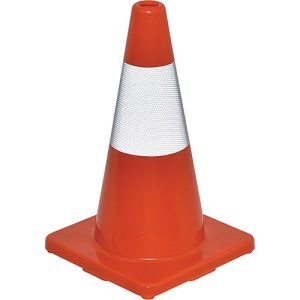One of the problems about the blogs and articles featured on the Burghwallis website is the need to make them relevant to the village. This has a drawback as they tend to focus on litter, speeding and dog deposits. Nothing unusual about that, these are the hot topics in virtually every village in the UK.
The opportunity to pick up on a new theme was recently suggested by a resident. He said ‘go write about road cones – they are a constant feature in the village.’ And thus in answer to the resident who shall remain nameless but for the sake of argument we will call him ‘Duncan Murray,’ look what you started:-

Over the past couple of months the closure of The Abbè’s Walk on even dates and Grange Lane on odd dates has seen an abundance of our friends the road cone. First invented in 1914 by an American, Charles P. Rudabaker these boys were originally made from concrete. They commanded drivers’ attention par excellence. A side swipe could ruin your day and chip the paintwork – big time. The downside, shipping them about and storing them pre Amazon days created a nightmare and bad backs. You can’t easily stack a solid concrete cone, although they could be recycled as sea defences.
There was a need for a rethink; a stackable, more forgiving cone was needed. Another American chap called Charles Scanlon rose to the challenge and possible set a pre-requisite to be called Charles to be able to design a cone. Mr Scanlon designed a cone made from rubber. More forgiving than concrete, they bounced back like the proverbial ball when clouted. And they stacked, but weighed a ton.
Britain in the meantime also thought road cones could be an asset. Thus in 1958 the UK were invaded by rubber cones, and what a splendid idea to adorn the construction of the M6, oh yay! But then the UK had some serious green thoughts. A British chap called David Morgan broke the mould, primarily as he wasn’t called Charles; he set about to design a new version made from plastic. They were lightweight and hollow, they stacked perfectly and cost not a lot.
Formed from thermoplastic they can be made from recycled plastic. This created a dilemma of the chicken and egg variety. As road repairs ideally need road cones, the manufacturers provided same. But then the recycling guys asked what the hell can we do with all this plastic waste, including squashed road cones Turn it into more road cones came the answer. And the viscous cycle began. Virtually every major road is now used to store them with mile after mile lying in tight formation, including Abbè’s Walk and Grange Lane. But are we alone? Who has the most road cones I hear you ask, and if not, I’m going to tell anyway.
New Zealand has the most cones per head of population in the world. This is safe to say as who the hell is going to count the beggars. Whereas New Zealand also has more sheep than people this has a benefit as you can eat sheep to keep the numbers down and the wool is now a much sought after insulation in our tightened energy times. But next on the list there are more road cones than people, which are not edible, yet. (I refer to the cones and not the people)
In fact there are an estimated 140 million cones in the world and after we have collected all the tossed plastic litter from our roads and seashores and turned it into road cones we could have a few trillion in five years, and then send them all to Russia as they won’t all fit on The Abbè’s Walk for sure.
Should you have a topic we should cover please contact us using the button in the top right corner.
